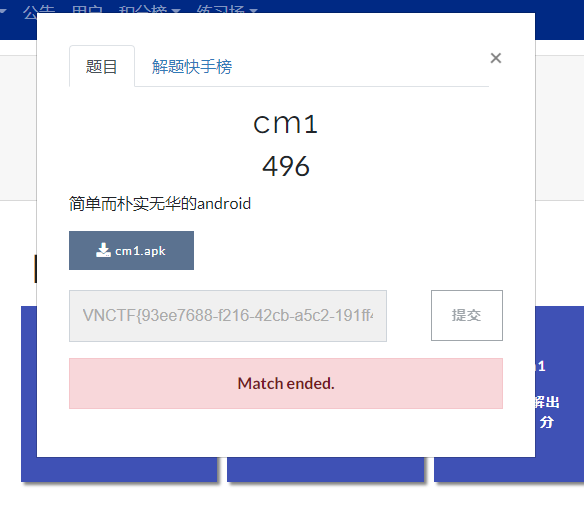1
2
3
4
5
6
7
8
9
10
11
12
13
14
15
16
17
18
19
20
21
22
23
24
25
26
27
28
29
30
31
32
33
34
35
36
37
38
39
40
41
42
43
44
45
46
47
48
49
50
51
52
53
54
55
56
57
58
59
60
61
62
63
64
65
66
67
68
69
70
71
72
73
74
75
76
77
78
79
80
81
82
83
84
85
86
87
88
89
90
91
92
93
94
95
96
97
98
99
100
101
102
103
104
105
106
107
108
109
110
111
112
113
114
115
116
117
118
119
120
121
122
123
124
125
126
127
128
129
130
131
132
133
134
135
136
137
138
139
140
141
| import java.util.Arrays;
public class vnctfcm1apk{
public static byte[] bencrypt(byte[] input, byte[] keys) {
return input.length == 0 ? input : toByteArray(encrypt(toIntArray(input, false), toIntArray(keys, false)), false);
}
public static int[] encrypt(int[] input, int[] keys) {
System.out.println("input: " + Arrays.toString(input));
System.out.println("keys : " + Arrays.toString(keys));
int rounds = 52 / input.length + 6;
int rnd_s = 0;
int prev_int = input[input.length - 1];
do {
rnd_s += -1640531527;
int rnd_e = rnd_s >>> 2 & 3;
System.out.println("[rnd_e:" + rnd_e + ", rnd_s:" + rnd_s + "]");
int ind;
for(ind = 0; ind < input.length - 1; ++ind) {
int ind_chr = input[ind] + ((prev_int >>> 5 ^ input[ind + 1] << 2) + (input[ind + 1] >>> 3 ^ prev_int << 4) ^ (rnd_s ^ input[ind + 1]) + (keys[ind & 3 ^ rnd_e] ^ prev_int));
input[ind] = ind_chr;
prev_int = ind_chr;
}
int next_int = input[0];
int last_ind = input.length - 1;
int lc = input[last_ind] + ((prev_int >>> 5 ^ next_int << 2) + (next_int >>> 3 ^ prev_int << 4) ^ (rnd_s ^ next_int) + (keys[ind & 3 ^ rnd_e] ^ prev_int));
input[last_ind] = lc;
prev_int = lc;
--rounds;
}
while(rounds > 0);
System.out.print("try encrypt: [");
for(byte a:toByteArray(input, false)){
System.out.print(a + ",");
}
System.out.println("]");
return input;
}
public static int[] decrypt(int[] aim, int[] keys){
int[] preaim = new int[aim.length];
int[] rnd_s = new int[]{-1640531527,1013904242,-626627285,2027808484,387276957,-1253254570,1401181199,-239350328,-1879881855,774553914};
int[] rnd_e = new int[]{2,0,2,1,3,1,3,2,0,2};
for(int rnd=9;rnd>=0;rnd--){
int ind = aim.length - 1;
int last_ind = aim.length - 1;
int prev_int = aim[last_ind-1];
int next_int = aim[0];
int lc = aim[last_ind];
preaim[last_ind] = (lc - ((prev_int >>> 5 ^ next_int << 2) + (next_int >>> 3 ^ prev_int << 4) ^ (rnd_s[rnd] ^ next_int) + (keys[ind & 3 ^ rnd_e[rnd]] ^ prev_int)) );
for(ind = aim.length - 1 -1; ind>=0; ind--){
if(ind==0) prev_int = preaim[aim.length-1];
else prev_int = aim[ind-1];
next_int = preaim[ind+1];
preaim[ind] = (aim[ind] - ((prev_int >>> 5 ^ next_int << 2) + (next_int >>> 3 ^ prev_int << 4) ^ (rnd_s[rnd] ^ next_int) + (keys[ind & 3 ^ rnd_e[rnd]] ^ prev_int)) );
}
aim = preaim;
}
System.out.print("try decrypt: [");
for(byte a:toByteArray(aim, false)){
System.out.print(a + ",");
}
System.out.println("]");
System.out.print("try flag: ");
for(byte a:toByteArray(aim, false)){
System.out.print((char)a);
}
System.out.println("");
return aim;
}
public static void main(String[] argc){
int rounds = 7;
byte[] aim_byte=new byte[]{68, 39, -92, 108, -82, -18, 72, -55, 74, -56, 38, 11, 60, 84, 97, -40, 87, 71, 99, -82, 120, 104, 0x2F, -71, -58, -57, 0, 33, 42, 38, -44, -39, -60, 0x71, -2, 92, -75, 0x76, -77, 50, (byte)0x87, 43, 0x20, -106};
int[] aim_int =new int[]{0b1101100101001000010011101000100,0b11001001010010001110111010101110,0b1011001001101100100001001010,0b11011000011000010101010000111100,0b10101110011000110100011101010111,0b10111001001011110110100001111000,0b100001000000001100011111000110,0b11011001110101000010011000101010,0b1011100111111100111000111000100,0b110010101100110111011010110101,0b10010110001000000010101110000111};
byte[] try_byte=new byte[]{86,78,67,84,70,123,57,51,101,101,55,54,56,56,45,102,50,49,54,45,52,50,99,98,45,97,53,99,50,45,49,57,49,102,102,52,101,52,49,50,98,97,125,0};
decrypt( toIntArray(aim_byte, false), toIntArray("H4pPY_VNCTF!!OvO".getBytes(), false) );
int[] ens = new int[11];
ens = encrypt( toIntArray(try_byte, false) , toIntArray("H4pPY_VNCTF!!OvO".getBytes(), false) );
System.out.println("encoded msg length = " + toByteArray(ens, false).length);
}
private static int[] toIntArray(byte[] arg7, boolean arg8) {
int[] result;
int v0 = (arg7.length & 3) == 0 ? arg7.length >>> 2 : (arg7.length >>> 2) + 1;
if(arg8) {
result = new int[v0 + 1];
result[v0] = arg7.length;
}
else {
result = new int[v0];
}
int i;
for(i = 0; i < arg7.length; ++i) {
int v3 = i >>> 2;
result[v3] |= (arg7[i] & 0xFF) << ((i & 3) << 3);
}
return result;
}
private static byte[] toByteArray(int[] arg5, boolean arg6) {
int n = arg5.length << 2;
if(arg6) {
int m = arg5[arg5.length - 1];
if(m > n) {
return null;
}
n = m;
}
byte[] result = new byte[n];
int i;
for(i = 0; i < n; ++i) {
result[i] = (byte)(arg5[i >>> 2] >>> ((i & 3) << 3) & 0xFF);
}
return result;
}
}
|
